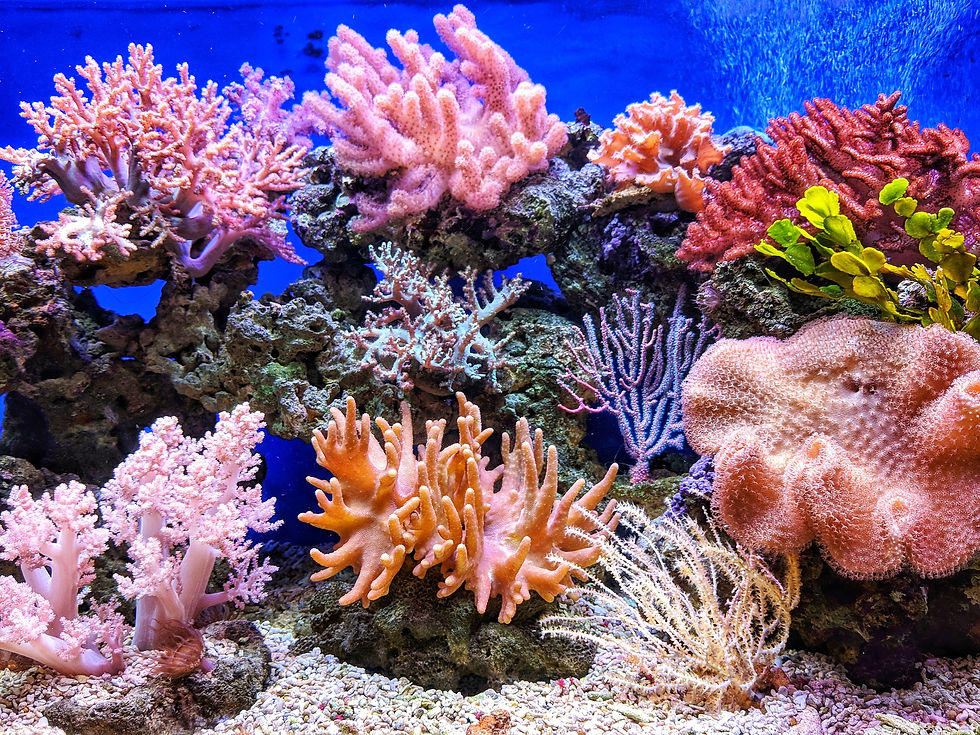How fashion brands have become more eco-friendly to protect our oceans.
- Ravail Khan

- Jun 21, 2021
- 3 min read
Updated: Aug 16, 2021
Each year, over 8 million tons of plastic waste enters and pollutes our oceans. This pollution poses a dangerous threat to human health, the marine ecosystems and the planet as a whole.
Unlike natural materials, plastic in the ocean does not biodegrade. Instead it breaks down into smaller pieces and is consumed by the sea life, meaning it is in turn consumed by us too. The plastics are also an immense source of harmful greenhouse gas emissions, emitting more and more gas as they degrade over time – damaging our environment and contributing to climate change.
Recent research has also strikingly shown that by 2050, there will be more plastic waste in the oceans than fish. A significant contributor to this issue is the fashion industry, particularly with the trends of fast fashion and consumerism, where little thought is put into the ethics behind the products.
For a long time, brands have been designing their clothing and packaging using plastics – especially polyester, acrylic and nylon – which is profitable for the companies as the materials are easily accessible, cheap to use and can be mass-produced.
However this is massively harmful for our oceans as the products are only used a few times before being discarded by the consumer and ending up in either landfills or the oceans. Today, an estimated 1.4 million trillion microfibres pollute and damage our oceans.
Fashion from the sea
Recognising the urgency of the issues at play, several fashion brands have taken responsibility and decided to adopt a more environmentally conscious and ethical approach by turning to recycling marine waste and using natural materials for their textiles.
Brands taking action to reduce ocean pollution and create ethical fashion
Here’s a look at some of the brands playing their part in creating eco-friendly fashion to protect our oceans:
Reformation’s eco-friendly swimwear collection is made from ECONYL, a regenerated nylon fibre made out of recycled waste such as fishing nets, fabric scraps and industrial plastic from the ocean. ECONYL can also be recycled infinitely with no waste, helping to create a more circular fashion system and minimising harm to the environment. Reformation also ensures that no hazardous chemical dyes are used in their fabrics – making their collection all the more eco-friendly.
Californian brand L*Space’s ‘Eco Chic’ range includes eco-friendly swimwear made of 100% recycled materials, including materials which come directly from the ocean. REPREVE polyster is made from recycled plastic bottles, while ECONYL is a 100% regenerated nylon fibre made from fishnets and recycled plastic waste.
Since 2015, Adidas has collaborated with the non-profit organisation Parley For The Oceans to produce footwear and athleticwear made from recycled ocean plastics, like fishnets and plastic bottles, instead of harmful virgin plastics.
As well as recycling waste directly from the ocean, Parley aims to cut down on the accumulation of new waste by intercepting plastic waste before it reaches the ocean and upcycling it for their sportswear collection.
Each one of Fair Harbor’s Nautilus Boardshorts are made using 11 plastic bottles which are collected from the ocean, thoroughly shredded and cleaned, then melted down and upcycled into yarn which gets transformed into recycled polyester. Currently, Fair Harbor has upcycled over 7,6000,000 bottles to create their signature shorts and swimwear.
Natural solutions
Recently, innovative brands have turned to natural plant sources from the ocean, such as seaweed and algae, as a new sustainable material for their textiles. Both are a great choice for environmentally conscious brands and consumers as they are regenerative, carbon sequestering and 100% biodegradable. However, they are currently relatively scarce materials, and so for now are more appropriate for slow fashion brands.
Certified seaweed fabrics have been used in Leticia Credidio’s 2019 limited-edition collection, ‘The Ocean’, to create luxury loungewear that isn’t only eco-friendly, but great for your skin too. Meanwhile, sustainable fashion brand Pangaia combines organic cotton with saltwater seaweed fibre, to make eco-friendly t-shirts. The shirts are also treated with natural peppermint oil to keep them fresh for longer, helping to reduce water waste.
A small but increasing number of innovators have begun to use algae to produce zero-waste, biodegradable textiles which have great strength and flexibility.
In 2015, experimental German design studio Blond & Bieber began using natural textile dyes derived from various species of microalgae.
Their dyes are great for most skin types, as well as biodegradable and eco-friendly. And in 2019 Kanye West revealed his sustainable Yeezy Foam Runner shoes, which are made partly from pond-sourced, harvested algae foam.



Comments